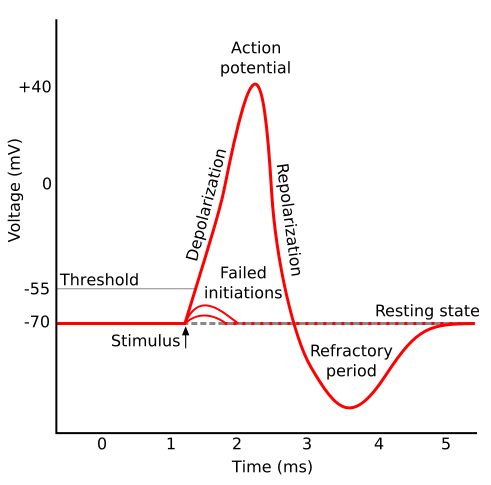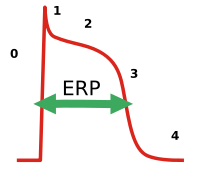Absolute Refractory Period Action Potential

Schematic of an electrophysiological recording of an action potential showing the various phases which occur as the moving ridge passes a betoken on a cell membrane.

Effective Refractory Menses
| WikiDoc Resource for Refractory catamenia |
| Articles |
|---|
| Most recent articles on Refractory period Most cited manufactures on Refractory period Review articles on Refractory period Articles on Refractory flow in N Eng J Med, Lancet, BMJ |
| Media |
| Powerpoint slides on Refractory period Images of Refractory menses Photos of Refractory period Podcasts & MP3s on Refractory flow Videos on Refractory period |
| Evidence Based Medicine |
| Cochrane Collaboration on Refractory period Bandolier on Refractory period TRIP on Refractory catamenia |
| Clinical Trials |
| Ongoing Trials on Refractory flow at Clinical Trials.gov Trial results on Refractory period Clinical Trials on Refractory period at Google |
| Guidelines / Policies / Govt |
| Usa National Guidelines Clearinghouse on Refractory period NICE Guidance on Refractory period NHS PRODIGY Guidance FDA on Refractory period CDC on Refractory period |
| Books |
| Books on Refractory period |
| News |
| Refractory menstruum in the news Be alerted to news on Refractory menses News trends on Refractory period |
| Commentary |
| Blogs on Refractory period |
| Definitions |
| Definitions of Refractory period |
| Patient Resources / Community |
| Patient resource on Refractory flow Word groups on Refractory period Patient Handouts on Refractory period Directions to Hospitals Treating Refractory menstruation Risk calculators and risk factors for Refractory flow |
| Healthcare Provider Resource |
| Symptoms of Refractory period Causes & Risk Factors for Refractory period Diagnostic studies for Refractory catamenia Handling of Refractory menstruation |
| Continuing Medical Educational activity (CME) |
| CME Programs on Refractory period |
| International |
| Refractory period en Espanol Refractory menstruum en Francais |
| Business |
| Refractory period in the Market place Patents on Refractory period |
| Experimental / Informatics |
| Listing of terms related to Refractory period |
Editor-In-Chief: C. Michael Gibson, Chiliad.S., K.D. [1]
Overview
In physiology, a refractory period is a flow of time during which an organ or cell is incapable of repeating a particular activeness, or (more than precisely) the corporeality of time it takes for an excitable membrane to exist fix for a second stimulus one time it returns to its resting land post-obit an excitation. It most commonly refers to electrically excitable muscle cells or neurons.
Electrochemical usage
- See also: Action potential
After initiation of an action potential, the refractory period is defined ii ways:
- The absolute refractory period is the interval during which a second action potential admittedly cannot exist initiated, no matter how big a stimulus is practical.
- The relative refractory menstruation is the interval immediately post-obit during which initiation of a 2nd activeness potential is inhibited but non incommunicable.
The accented refractory catamenia coincides with well-nigh the unabridged duration of the action potential. In neurons, information technology is caused by the closure and inactivation of the Na+ channels that originally opened to depolarize the membrane. These channels remain inactivated until the membrane repolarizes, subsequently which they regain their ability to open in response to stimulus.
The relative refractory menstruum immediately follows the absolute. As voltage-gated potassium channels open to terminate the action potential by repolarizing the membrane, the potassium conductance of the membrane increases dramatically. K+ ions flooding out of the cell bring the membrane potential closer to the equilibrium potential for potassium. This causes brief hyperpolarization of the membrane, that is, the membrane potential becomes transiently more negative than the normal resting potential. Until the potassium conductance returns to the resting value, a greater stimulus will be required to reach the initiation threshold for a second depolarization. The return to the equilibrium resting potential marks the end of the relative refractory flow.
Cardiac refractory period
The refractory period in cardiac physiology is related to the ion currents which, in cardiac cells every bit in nerve cells, menses into and out of the cell. The flow of ions translates into a change in the voltage of the inside of the cell relative to the extracellular space. As in nerve cells, this characteristic change in voltage is referred to as an action potential. Unlike nerve cells, the cardiac action potential duration is closer to 100 ms (with variations depending on prison cell type, autonomic tone, etc.). Afterwards an activity potential initiates, the cardiac cell is unable to initiate another activity potential for some duration of time (which is slightly shorter than the "true" activity potential elapsing). This menstruum of time is referred to every bit the refractory period.
Classically, the cardiac refractory period is separated into an absolute refractory menstruation and a relative refractory menses. During the accented refractory flow, a new action potential cannot be elicited. During the relative refractory menstruum, a new activeness potential tin can be elicited under the correct circumstances.
Neurology refractory catamenia
The refractory flow in a neuron occurs after an action potential and generally lasts i millisecond. An action potential consists of three phases. Phase one is depolarization. During depolarization, voltage-gated sodium ion channels open increasing the neuron's membrane conductance for sodium ions and depolarizing the cell'southward membrane potential (ordinarily from -90mV towards 0). Phase two is repolarization. During repolarization, voltage-gated sodium ion channels inactivate (close) due to the now depolarized membrane, and voltage-gated potassium channels activate (open). Both the sodium ion channels closing and the potassium ion channels opening human action to repolarize the cell'south membrane potential dorsum to its resting membrane potential. When the cell's membrane voltage overshoots its resting membrane potential (generally -90mV), the cell enters a stage of hyperpolarization. This is due to a larger than resting potassium conductance across the cell membrane. Eventually this potassium conductance drops and the cell returns to its resting membrane potential.
The refractory periods are due to the inactivation property of voltage-gated sodium channel and the lag of potassium channels in closing. Voltage-gated sodium channels have 2 gating mechanisms, i that opens the aqueduct with depolarization and the inactivation machinery that closes the channel with repolarization. While the channel is in the inactive state it volition not open in response to depolarization. The menstruum when the majority of sodium channels remain in the inactive state is the absolute refractory period. Later on this period there are enough voltage-activated sodium channels in the closed (active) state to reply to depolarization. Even so, voltage gated potassium channels that opened in response to depolarization don't shut equally apace as voltage gated sodium channels render to the active closed country. During this fourth dimension the extra potassium conductance means that the membrane is at a lower threshold and will crave a greater stimulus to cause action potentials to fire. This menstruum is the relative refractory menstruum.
Sexual refractory catamenia
In sexual intercourse, the refractory flow is a recovery phase after orgasm during which information technology is physiologically impossible for a person to experience continued arousal or additional orgasms. The clitoris/penis glans may exist hypersensitive and further sexual stimulation may even feel painful during this fourth dimension frame.
The refractory period varies widely betwixt individuals and beyond species, ranging from minutes to hours. An increased infusion of the hormone prolactin (which represses dopamine, which is responsible for sexual arousal) during orgasm is believed to be chiefly responsible for the refractory period and the amount past which prolactin is increased may touch on the length of each refractory period.
Another chemical which is considered to be responsible for this effect is oxytocin, although oxytocin has a one-half-life of typically nearly three minutes in the blood it would not create a long-term refractory menstruum.
Some individuals do not experience a refractory period immediately later orgasm and in many cases are capable of attaining additional, multiple orgasms through farther stimulation oral-genital stimulation or through masturbation). The female sexual response is more akin that of men than previously thought. Most men and women experience hypersensitivity later on orgasm, which effectively creates a refractory catamenia. During a refractory menses it is most impossible to be angry by physical stimulation alone, thus an element of mental stimulation is required to achieve further sexual pleasure .
In general it is the males of the species that have orgasm on a frequent basis (due to the design of the penis which makes it easier to accomplish orgasm) which in turn increases the levels of prolactin which represses the arousal properties of dopamine. Information technology is besides true that due to the way men rush their way to orgasm, or suppress their orgasm they are not building adequate amounts of the hormone dopamine leading to a less than satisfying orgasm with an inevitable refractory period.
Template:WikiDoc Sources
Absolute Refractory Period Action Potential,
Source: https://www.wikidoc.org/index.php/Refractory_period
Posted by: danielssoing1993.blogspot.com


0 Response to "Absolute Refractory Period Action Potential"
Post a Comment